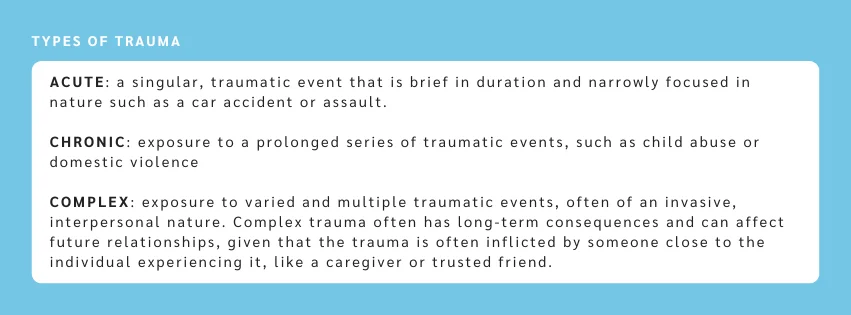
Discussing the Rise in Trauma: How Global Shared Trauma is Changing Treatment Plans and Modalities
Discussing the Rise in Trauma
Trauma is on the rise. In the last 20 years alone, Google searches for the term have nearly tripled. Discussions around “trauma” on social media platforms have risen almost 30% since 2022. Many clinicians have also witnessed an increased diagnosis of post-traumatic stress disorder coupled with trauma among college students within the last 5 years.
Admittedly, seeing a rise in trauma makes sense. The worldwide COVID-19 pandemic, the rise in mass shootings in America, and increased levels of police brutality have all contributed to the rise of both the term “trauma” and trauma diagnoses across the globe. While these factors have positively impacted the number of cases we’re seeing, they have also heightened the awareness and social conversation around trauma, leading to the emergence and implementation of “trauma-informed care.” In this article, we will discuss the basics of trauma (what it is, who it affects, why it’s continuously increasing), in addition to methods for finding and receiving proper care.
What is Trauma?
Trauma can be characterized as an event or circumstance that results in physical, emotional and/or life-threatening harm to an individual or group of people. These events have lasting adverse effects on the their mental, physical and emotional health as well as social and/or spiritual well being. Often these events are difficult to cope with and can even be out of our control.
The results of a traumatic event can differ in form and severity. Some people develop signs of acute stress disorder immediately after a traumatic event. Others develop symptoms of trauma later, in the form of post-traumatic stress or PTSD. Some develop entirely different mental health issues as a result of their trauma, which can result in several different trauma disorders, such as attachment disorder, adjustment disorder, or disinhibited social engagement disorder.
Who is Affected by Trauma?
Anyone of any age, gender, socioeconomic status, race, ethnicity, or sexual orientation can experience trauma. Trauma is not always an individual experience and can also have an impact on families and communities.

Why Are We Seeing This Increase?
The increase in reported and diagnosed trauma cases is closely tied to the state of our world. In the last 5 years alone, Americans have experienced a global pandemic, a rise in mass shootings, increased racial injustices, and climate-related disasters that have threatened our sense of stability and heightened our nation’s posttraumatic stress levels.
AAs the American Psychological Association confirms, trauma often leads to long-term heightened stress levels, which in turn can result in a variety of mental health conditions, affecting both our day-to-day lives and our mental outlook on the future. These mental health conditions also play a role in our physical health. During this time period, researchers and health practitioners have also witnessed global increases in body inflammation, digestive disorders, heart disease, weight gain.
According to the World Health Organization, 70% of people in 24 studied countries report experiencing traumas, with an average of 3.2 traumatic events per person in their lifetime. The rise in reports of trauma coupled with the observed decline in mental and physical health of the public, have made trauma-informed care an utmost priority for healthcare organizations and medical providers.
Where Do We Go From Here?
“Trauma informed care (TIC)” is defined by the Substance Abuse and Mental Health Services Administration (SAMHSA) as care “involving a broad understanding of traumatic stress reactions and common responses to trauma.” Because of the complexities involved with traumatic events, we know that it affects everyone differently. Some people may display the textbook criteria associated with trauma, while others may have more resilient responses or symptoms that fall outside of established diagnostic criteria.
Providers with a TIC focus specifically look to educate their clients using information and terms regarding the varied effects and responses to trauma, including:
- How to reframe recurring experiences of the event(s) and other physical symptoms as reactions to extreme stress.
- Communicate that treatment and other wellness activities can improve both psychological and physiological symptoms.
- Normalize trauma symptoms and explain to clients that their symptoms are not a result of weakness or a character flaw.
In addition to these strategies, it’s important to support clients and communicate a message of hope– they are not alone, they are not at fault, and recovery is not only possible, but it’s anticipated.
When Is It Time To Seek Help?
At Amend, seeking treatment for the effects of trauma, whether acute or chronic, requires a specialized knowledge base and skills set. This is why our clinicians are among the highest trained and experienced professionals in the industry.
A member of our team is always available to answer any questions you have about our residential treatment program, our trauma therapies, our approach, our community, and your needs, strengths and goals throughout this process.
Our client promise ensures that we will always deploy and use the most effective clinical and behavioral treatments to help our clients’ lasting transformation from hopelessness to optimism, confidence and belief – and we provide the tools to put them on a different path. Better mental wellness starts today.
Connect with our team to begin your journey today.
We are here for you.
Feel free to reach out to us to start your journey or if you have any questions. We’re here to assist you and look forward to connecting with you soon.
Admissions – (866) 726-0226
[email protected]
"*" indicates required fields
